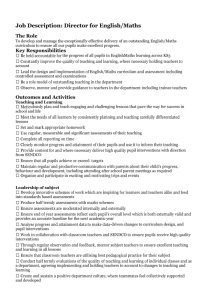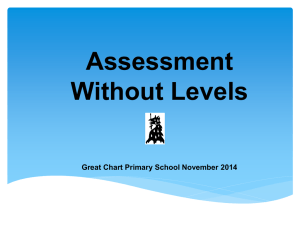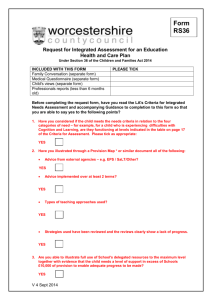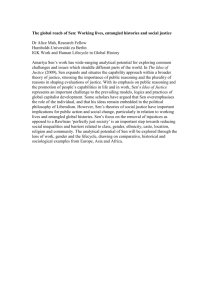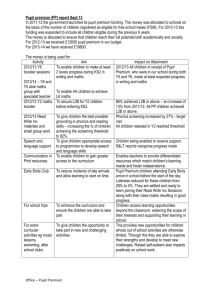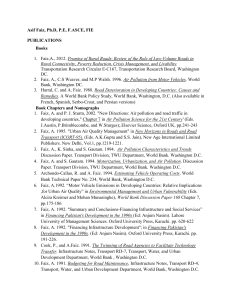MLD – Inclusion & Differentiation in a Maths Classroom
advertisement
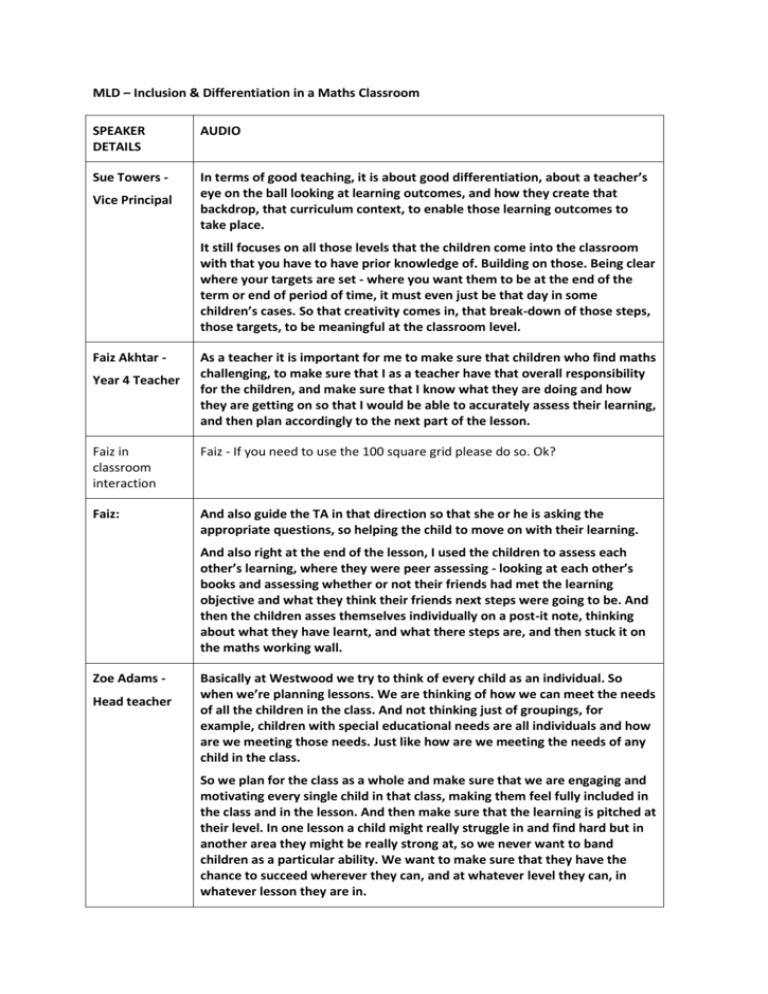
MLD – Inclusion & Differentiation in a Maths Classroom SPEAKER DETAILS AUDIO Sue Towers - In terms of good teaching, it is about good differentiation, about a teacher’s eye on the ball looking at learning outcomes, and how they create that backdrop, that curriculum context, to enable those learning outcomes to take place. Vice Principal It still focuses on all those levels that the children come into the classroom with that you have to have prior knowledge of. Building on those. Being clear where your targets are set - where you want them to be at the end of the term or end of period of time, it must even just be that day in some children’s cases. So that creativity comes in, that break-down of those steps, those targets, to be meaningful at the classroom level. Faiz Akhtar Year 4 Teacher As a teacher it is important for me to make sure that children who find maths challenging, to make sure that I as a teacher have that overall responsibility for the children, and make sure that I know what they are doing and how they are getting on so that I would be able to accurately assess their learning, and then plan accordingly to the next part of the lesson. Faiz in classroom interaction Faiz - If you need to use the 100 square grid please do so. Ok? Faiz: And also guide the TA in that direction so that she or he is asking the appropriate questions, so helping the child to move on with their learning. And also right at the end of the lesson, I used the children to assess each other’s learning, where they were peer assessing - looking at each other’s books and assessing whether or not their friends had met the learning objective and what they think their friends next steps were going to be. And then the children asses themselves individually on a post-it note, thinking about what they have learnt, and what there steps are, and then stuck it on the maths working wall. Zoe Adams Head teacher Basically at Westwood we try to think of every child as an individual. So when we’re planning lessons. We are thinking of how we can meet the needs of all the children in the class. And not thinking just of groupings, for example, children with special educational needs are all individuals and how are we meeting those needs. Just like how are we meeting the needs of any child in the class. So we plan for the class as a whole and make sure that we are engaging and motivating every single child in that class, making them feel fully included in the class and in the lesson. And then make sure that the learning is pitched at their level. In one lesson a child might really struggle in and find hard but in another area they might be really strong at, so we never want to band children as a particular ability. We want to make sure that they have the chance to succeed wherever they can, and at whatever level they can, in whatever lesson they are in. Will in classroom interaction Will: On your table should be a cup full of straws and one dice, ok. Will Hendy - My name is Will Hendy, I’m the class 5/6 teacher at Westwood Primary School in South Leeds. Year 5/6 Teacher I have some children who we would consider SEN and they have an individual education plan for numeracy and then I have certain children who are already above their expected level and I have some children that are far behind their expectation. I wanted all the children, especially my lower abilities and SEN groups, I wanted them to take part, so I planned for an activity where they would have a final answer at the end. I feel that’s very important in that they come away satisfied that they completed something that they’ve been able to push themselves. Classroom interaction Will: You are simply going to roll the dice 5 times. Ok? So you can take it in turns because you’re going to work as a pair against the pair sitting near you. Will: The learning objective for this morning’s maths lesson was to find pattern, whether it be in shape or number. I planned for a very visual activity so that it would incorporate the less able and more visual learners. I planned for an extension where the activity would go into quite a complex number pattern for the higher abilities. Classroom interaction Will: For each roll, say you roll a 3. You take that number of straws and you make a triangle. Will: I held back information from certain groups and I provided other groups with more information. For example, some groups had more straws so they could act it out, other groups were encouraged to draw it, one group had a table so they could start to record the information and look for number patterns Classroom interaction Pupil 1: 3, 6, 9, 12, 15, so 1, 2, 3, 4 triangles, we could make 4 triangles! Will: I wanted them to use lots of different calculations to come up with the answer at the end. I held back on lots of information initially to get them thinking, to try and get them experimenting. Classroom interaction Will: If you haven’t got something like this already… Will: I would expect all groups to be able to participate in the maths lesson. I don’t expect them to then go of somewhere else to do another activity with a TA for example. I expect them to stay in the lesson, be supported through different ways, whether it’s adult support or whether it’s an outcome support, but I expect them to stay with the lesson and be part of the lesson. For my SEN group I sit them close to a display board where there is current work up. In numeracy it’s always changing so a display can become very old so I try and update it with key words that we are going to do for that lesson which act as a big of a clue, or I want them to use that word in their answer. So we have things like “systematic” which is quite a complicated word, we had “formula” and “sequence”. Classroom interaction Will: We’ve looked at method, we’ve looked at trial and error, we are now going to become…? Connor? Connor: We have to be systematic. Teacher: We are going to become systematic Will: There is also current displays where there’s little rules and little patterns that we often rely on again and again in maths that are there in front of them, multiples are up there, times tables are up there. So where they sit is very important. In my class I try to encourage a culture it is okay to get something wrong. We’ve previously done a lot about what we call trial and error where we try something, we get it wrong but we use little bits of information to complete the puzzle. So if they do get the wrong answer it’s not a problem and often it can give us the right answer in the end. Sometimes we use the phrase ‘mistakes are our friends’ and they often, particularly in maths, help us work out where something has gone wrong. I would then ask pupils to spot misconceptions in a sum, I would get the answer wrong. They would then be able to explain why I got it wrong or why I might think that a certain answer is right. Classroom interaction Will: You’re on the right lines but how did you get ten? Pupil: Because 3 times 10 equals… Will: because 3 times 10 equals….? Pupil: 30 Will: Very Good Will: I think for SEN children to be allowed to make mistakes is very important. It builds their confidence when they find out if they get something wrong, nothing bad happens. But then it gives them the opportunity, and this works really well for SEN, is that they are given the chance to then talk about the answer, about what went wrong. They get to talk about their misconceptions, I can then challenge them, and we can talk about the method that they’ve used which really helps consolidate their learning. Classroom interaction Will: And see if you can do it in another way. Ohh look, nearly, nearly, nearly, a bit of a kind of curve isn’t it. That’s certainly different from the row. Oh not quite though. Will: For my group with SEN, I think they did very well. They didn’t come to the number pattern where they were spotting square numbers, but I didn’t expect them to. On their own, particularly Rio, he started investigating number pattern on his own, it wasn’t the right number pattern but he was off on his own and he was spotting using the numbers and making up his own addition facts to it. And that was great. And that for me that was exactly what I wanted, he was just playing around with number on his own and enjoying it as well. Classroom interaction Pupil: Like a pyramid. Will: Like a pyramid shape, excellent, well done! So, the pyramid shape is going to carry on here. That’s it! This is looking good. We’re on the 4th row here. Classroom interaction Pupil: 6. 4, 5, 6, 7, 8, 9. Will: Michael started really well. He looked at a very creative game with his partner Thomas right at the beginning, and in fact, he was almost 2 steps ahead there, where he was looking at creating the most amount of triangles with the fewest number of straws. Classroom interaction Will: Anybody got 3 or more? 4 or more? 5 or more? Oh. Right then, how many have you made? Michael and Thomas: 7 Will: 7?! How have you made 7 then?! Have you been cheating? Thomas: No, because we had a straw left, and then… Michael: We put it across the top. Thomas: …but we saw them 2, and then we just thought we might as well put it on the top. Will: Which basically gave everybody the idea of how to solve making nine triangles with fewer straws. So I think that gave him a real boost that people used his idea and again we encourage people to talk about their ideas and then we take them and we try them out and he did really well. And he was able to then put it into a table and begin to then look at the number patterns and the number sequences. Classroom interaction Will: 13, 14, 15, so they have used all of their straws haven’t they. Will: In order to ensure good progression through the SEN pupils and to try and create a more independent pupil for those groups. I try to mix my adult support, sometimes the TA will work with this group, but I really try as much as possible for them to work independently. There’s always the support if they need it and they know if they are stuck they stick their hand up and they come and ask. Encouraging independent learning is really important. Through my questioning I can extend their learning. I can ask them direct questions that I know, the questions that I’ve planned for, and the objectives I can really push. So it is having a really high expectation of their outcome as well, and not thinking that because they are a SEN group they can get away with the bare minimum. I really try and push that group as much as I would do with my higher ability as well.
